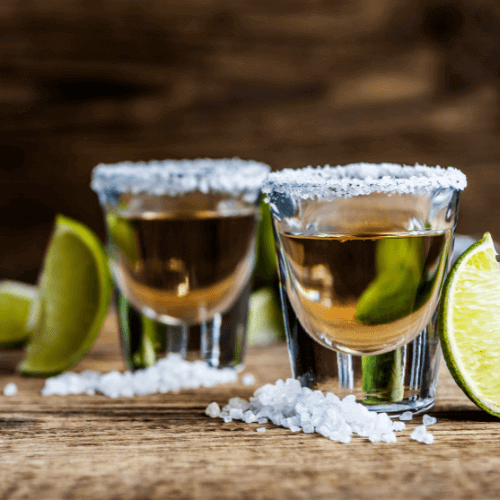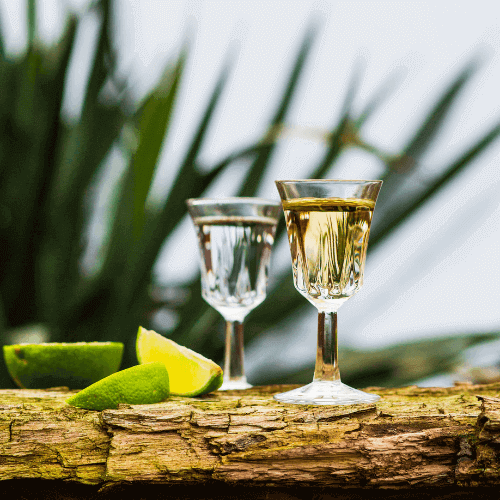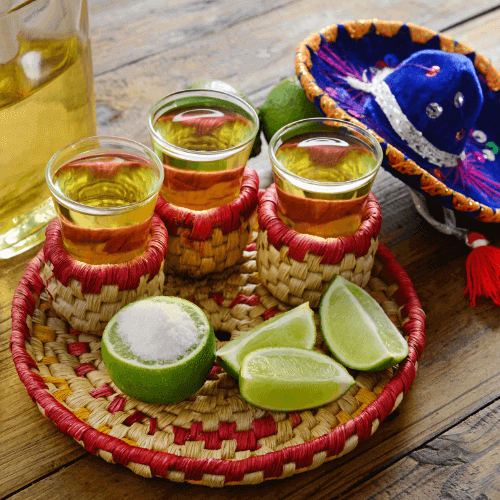Facebook Print Email WhatsApp Updated: 12/27/23 Table of Contents The Cuba Libre, meaning “Free Cuba”, is an iconic Cuban cocktail...

Tequila is an alcoholic drink produced from the blue agave plant, made from the heart of the plant known as the piña, and it is originating from Mexico. The process of creating tequila involves several steps, showcasing the craftsmanship and tradition associated with this iconic drink.
This remarkable liquor has gained international acclaim for its versatility in cocktails and sipping experiences. Margaritas, tequila sunrises, and palomas are just a few examples of popular tequila-based cocktails enjoyed worldwide.
The journey of tequila begins with the cultivation of blue agave plants, which can take several years to reach maturity. Once the plants are harvested, the piñas are extracted, roasted, and cooked.
After cooking, the piñas are crushed to extract the sugary juice, which is then fermented using yeast. This fermentation process typically takes several days and produces a low-alcohol liquid known as “mosto.” The mosto is then distilled to create tequila. The distillation process involves heating the liquid and separating the alcohol from impurities, resulting in a clear spirit.
The maturation of tequila leads to additional variations of the spirit. Reposado tequila is aged in oak barrels for a minimum of two months, acquiring a smoother taste and a golden hue. Añejo tequila undergoes a lengthier aging process of at least one year, resulting in a rich, complex profile with notes of vanilla and caramel.
To be considered tequila, the spirit must be produced in specific regions of Mexico, including Jalisco, Guanajuato, and more. As said, tequila can be categorized into different types based on aging, including Blanco (unaged at all or aged up to four weeks), reposado (aged for a period of at least two months), añejo (aged for a period of leastways one year), and extra añejo (aged for a period of leastways three years).
Tequila is not just a drink, it is deeply intertwined with Mexican culture and heritage. It is celebrated as the national drink of Mexico and is often enjoyed during festive occasions and gatherings. Whether sipped slowly or enjoyed in a vibrant cocktail, tequila brings people together, fostering conviviality and a sense of shared enjoyment.

Tequila is known for its distinct flavor profile that sets it apart from other alcoholic beverages. When it comes to describing the taste of tequila, a few key characteristics come to mind. First and foremost, tequila carries a bold and robust flavor. It can be earthy, with hints of agave, the plant from which it is made, and a touch of sweetness. Depending on the type of tequila, whether it’s a blanco, reposado, or añejo, the taste may vary.
Blanco tequilas are typically unaged and exhibit a clean, crisp flavor with citrus notes and a slight peppery kick. Reposado tequilas have been aged in oak barrels for a few months, resulting in a smoother and more rounded taste. They may showcase notes of vanilla, caramel, and oak, while still retaining the essence of agave. Añejo tequilas, aged for at least a year, offer a complex and sophisticated taste. They often present rich flavors of dark chocolate, roasted nuts, and a gentle smokiness.
Overall, tequila can be described as a liquor that balances the natural sweetness of agave with various notes that develop during the aging process.
By law, tequila must have a minimum alcohol content of 38% in order to be considered authentic. This requirement ensures that tequila retains its unique characteristics and delivers the desired effects. However, it’s important to note that not all tequilas are created equal in terms of alcohol percentage. The range typically varies from 38% to 55%, with most commonly available brands falling between 38% and 40%.
The alcohol percentage in tequila plays a vital role in defining its flavor and intensity. Higher alcohol content often leads to a more potent and robust taste, as it enhances the spirit’s heat and intensity on the palate. It can also contribute to a long finish and a stronger alcohol burn, particularly when consumed neat or in shots.
On the other hand, tequilas with a lower alcohol percentage tend to offer a smoother and more approachable experience. The reduced alcohol content allows for the nuances of the agave plant to shine through, resulting in a milder taste and a more balanced profile.
Ultimately, the choice of tequila alcohol percentage comes down to personal preference and the intended use. Whether sipped slowly to savor the complex flavors or used as a base for cocktails, tequila’s alcohol content remains an essential aspect that adds depth and character to this beloved spirit.

When it comes to purchasing tequila, there are several options available for enthusiasts and casual consumers alike. The first and most obvious choice is to visit your local liquor store or supermarket. These stores often carry a wide selection of tequila brands, ranging from well-known names to less-known varieties. The advantage of shopping in person is the ability to browse the shelves, ask questions to knowledgeable staff, and potentially sample different options before making a purchase.
Another popular option is to explore online retailers. With the convenience of e-commerce, numerous websites specialize in selling spirits, including tequila. Online platforms provide the advantage of a vast selection, competitive pricing, and the convenience of doorstep delivery. However, it’s essential to check the credibility and reputation of the online retailer before making a purchase.
For those seeking a more immersive experience, visiting a tequila distillery in Mexico is an unparalleled option. This allows you to witness the production process firsthand, gain insights from experts, and potentially purchase exclusive and limited-edition bottles directly from the source.

When it comes to tequila prices, there is a broad spectrum to consider. At the lower end, one can find entry-level tequilas that are often unaged or minimally aged. These tequilas, known as blanco or silver, are typically priced more affordably, making them accessible to a wider audience. Their flavor profiles tend to be vibrant and agave-forward, making them ideal for cocktails or sipping.
Moving up the price ladder, we encounter reposado and añejo tequilas. Reposado tequilas are aged for a minimum of two months but less than a year, while añejo tequilas are aged for a minimum of one year, up to three years, and maybe more. The additional aging imparts more complexity, depth, and smoothness to the spirit, leading to higher price tags. These tequilas are often enjoyed neat or on the rocks to fully appreciate their refined flavors.
Finally, at the upper end of the price spectrum, we find extra añejo tequilas. These tequilas are aged for a minimum of three years in oak barrels, resulting in a luxurious and velvety texture. Extra añejos boast intricate flavor profiles, often displaying notes of caramel, vanilla, and dark chocolate. The extended aging process, coupled with limited production, contributes to their premium prices.
It is important to note that while price can be an indicator of quality and craftsmanship, it is not always the sole determinant. Personal preferences, brand reputation, and rarity of production also factor into tequila prices. Ultimately, the decision of which tequila to purchase should be based on individual taste preferences and budgetary considerations.

| Made from | The heart of the blue agave plant known as the piña |
| Taste description of Tequila | Can be described as a liquor that balances the natural sweetness of agave with various notes that develop during the aging process |
| ABV | 38% to 55% |
| Price range | There are a variety of prices for tequila, depending on the type and place of purchase |
Facebook Print Email WhatsApp Updated: 12/27/23 Table of Contents The Cuba Libre, meaning “Free Cuba”, is an iconic Cuban cocktail...
Facebook Print Email WhatsApp Table of Contents The classic Margarita has long been celebrated as a timeless and iconic cocktail,...
Table of Contents The Woo Woo cocktail is a delightful combination of three key ingredients: vodka, peach schnapps, and cranberry...
Facebook Print Email WhatsApp Table of Contents The Naked and Famous cocktail is a blend of equal parts mezcal, yellow...
MixDrinkiPedia.com is a participant in the Amazon.com Services LLC Associates Program. As an Amazon Associate we earn from qualifying purchases. Amazon and the Amazon logo are trademarks of Amazon.com, Inc. or its affiliates.